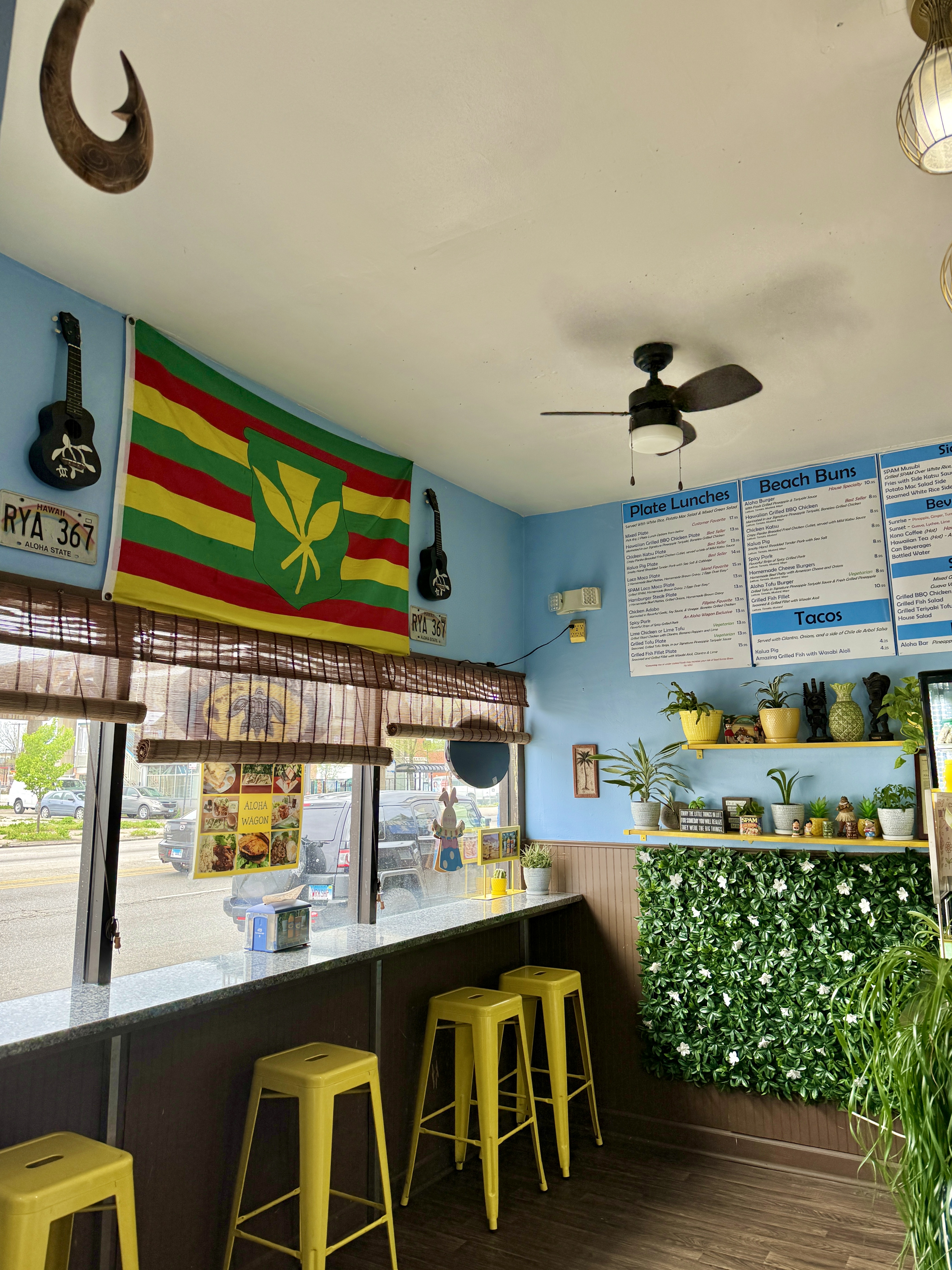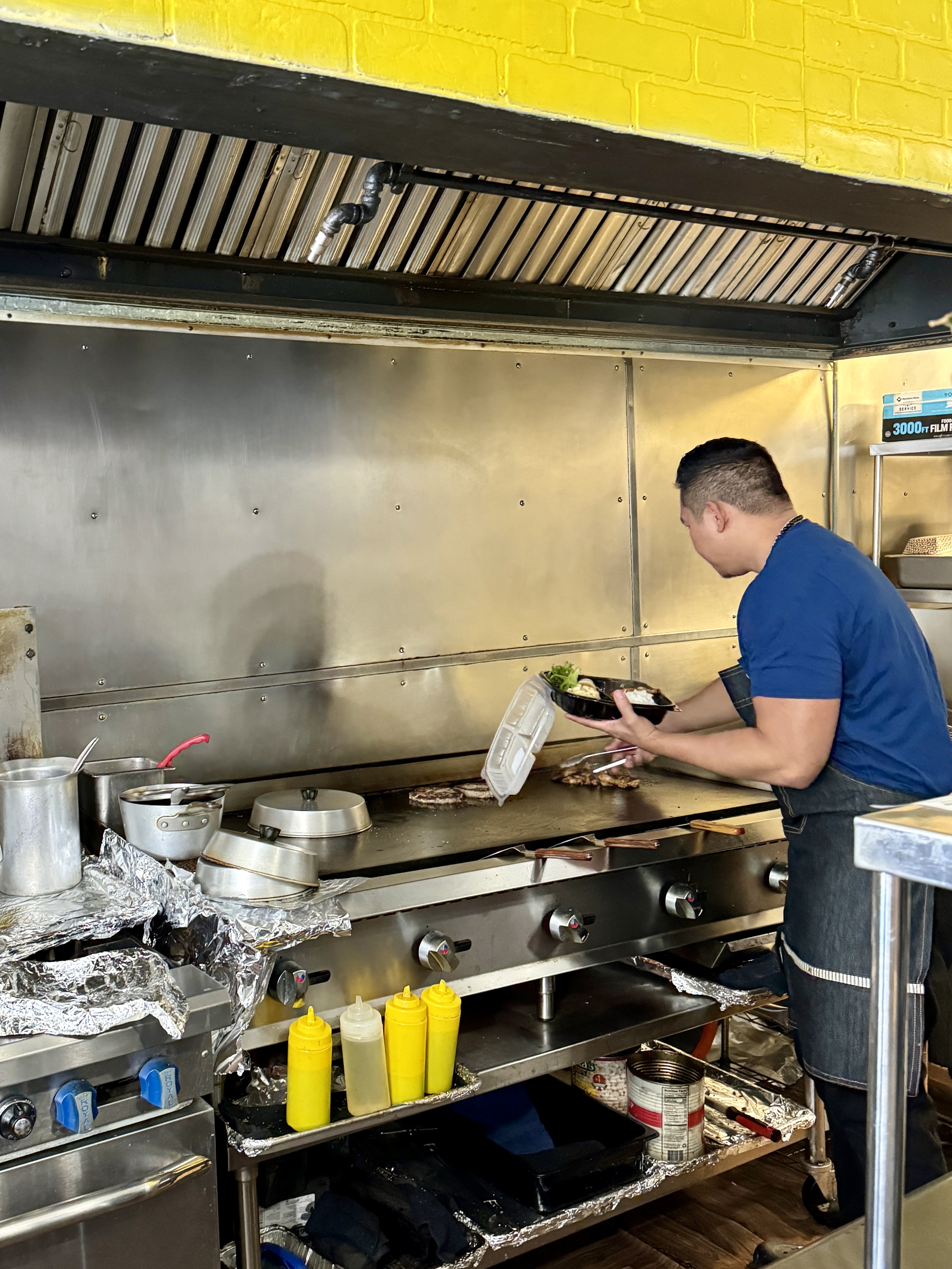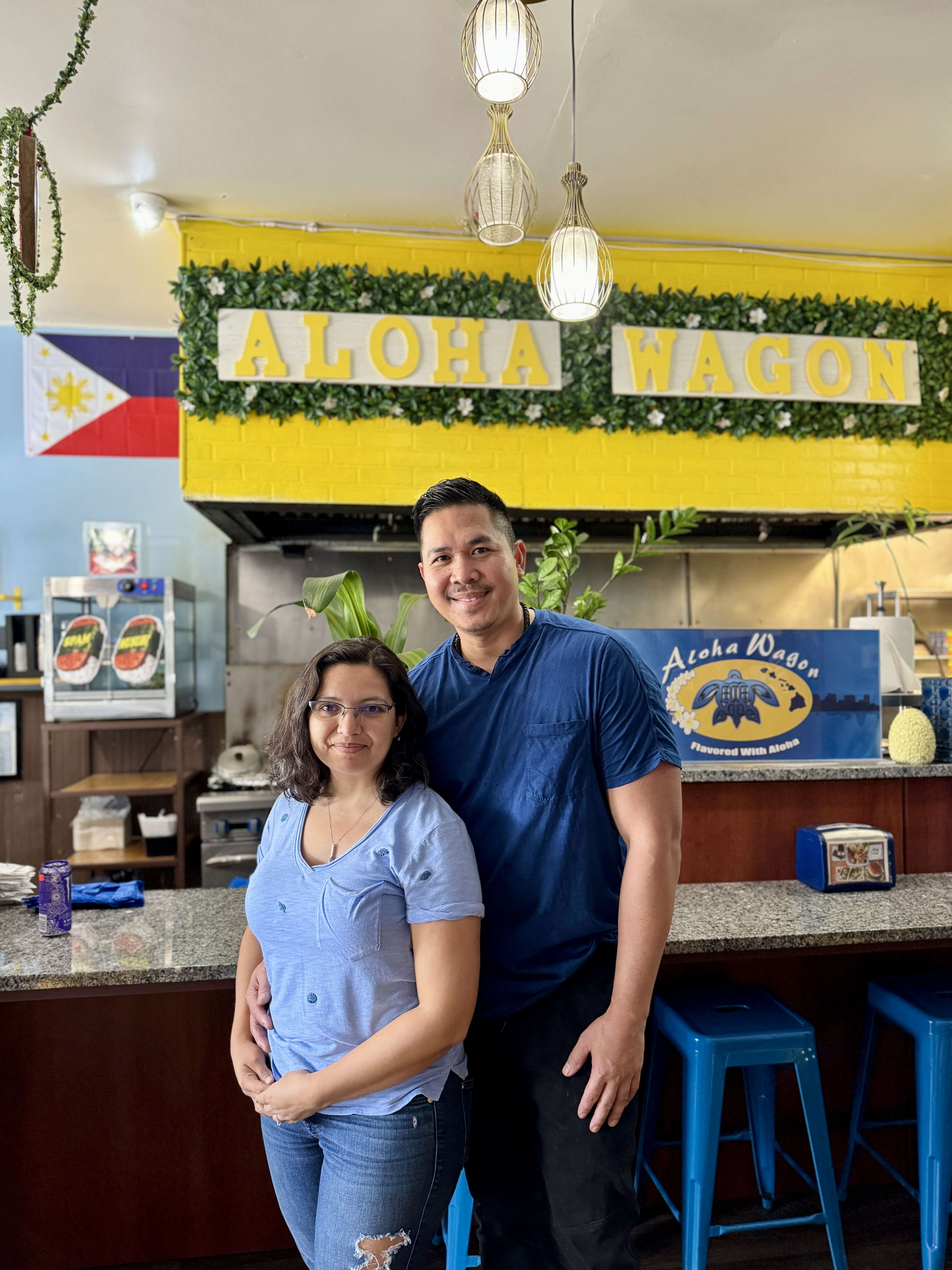As soon as the opening time of 11 a.m. hits, a string of customers streams through Aloha Wagon’s door, greeted with breezy ocean air (from the three ceiling fans spinning on high), peppy island tunes and the sound and smell of a sizzling grill.
The sky-blue walls are decorated with potted plants and memorabilia from the islands, resembling the tranquil, easygoing and peaceful atmosphere of a beach hut in Hawai’i.

Wall decor includes Aloha Wagon’s menu, the license plate of the restaurant’s food truck, two ukuleles gifted by a customer and the Kingdom of Hawai’i’s flag. Photo by Lydia Schultz.
The Windy City may be worlds away from the Pacific islands, but the spirit of aloha can be felt anywhere. Aloha is a greeting representing love, peace and affection in Hawai’i.
Aloha Wagon’s owners, Rebecca Romo and Richard Manongdo, spread aloha through fresh, home-cooked Hawaiian food with a twist.
As captioned on one of Aloha Wagon’s Instagram posts, “The location doesn’t make the food good, good food makes the location!”
Returning customer Angela, who often visits her family on the Big Island of Hawai’i, agrees.
“It’s better than what I had in Hawai’i,” she said.

Richard Manongdo grilling burger patties for a lunch plate. Photo by Lydia Schultz.
Their menu features Hawaiian classics such as the Loco Moco plate lunch, which includes two beef patties and fried eggs served with gravy, white rice, potato mac salad and a mixed green salad. They also sell SPAM musubi, which is canned meat on a bed of white rice wrapped in seaweed, and the renowned Kona coffee imported directly from the Big Island.
View this post on Instagram
These traditional Hawaiian menu items stem from a history of colonization and subsequent cultural mixing on the islands.
Hawai’i’s first inhabitants were Polynesian explorers who brought staple foods to the island like taro, bananas, breadfruit, fish and seaweed.
European settlers dramatically transformed Hawaiian cuisine. Traders from Europe and the United States claimed the land as their own (without Native Hawaiians’ consent) and established sugarcane and pineapple plantations.
Agricultural businesses in Hawai’i boomed once the United States overthrew the Kingdom of Hawai’i in 1893 and colonized the islands. Plantation owners relied on immigrant laborers from China, Japan, South Korea, Portugal, the Philippines and Puerto Rico because the diseases they brought diminished the population of Native Hawaiians.
This newfound diversity was exploited, as plantation owners enslaved some workers and forced others to work for very little money under terrible conditions. Over time, the mixing of cultures transformed Hawaiian cuisine. Each immigrant group brought new flavors to the islands (like rice from China, seasoned raw fish from Japan, kimchi from Korea) that are evident across Hawaiian dishes today.
However, Aloha Wagon seeks to break away from the traditional food scene, which is why customers will not find Hawaiian dishes like pokè bowls or shave ice.
Instead, house specialties include the Aloha Burger, made with grilled pineapple and teriyaki sauce, and tacos with Kalua pig or grilled fish.
View this post on Instagram
“That’s my favorite part — bringing in new products,” said Romo.
Romo’s intuition equally guides her personal life. After graduating from culinary school in 2004, she went to work for a Hawaiian cruise ship company.
“The experience really called my name,” Romo said. To live in Hawai’i for free? I was like, ‘Yes. Sign me up’.”
While working on the cruise ship she fell in love with Hawai’i. As Hawai’i planted roots into Romo’s heart, a different kind of love also blossomed.
In 2005, Romo met Manongdo, who also worked for the cruise ship company. In 2007, they got married and moved to Chicago so Romo could pursue her Masters in Business Administration.
After graduating and having two sons, the longing for Hawai’i tugged at Romo, leading to a spontaneous decision to start a food business on Oahu.
Romo and Manongdo brought their kids to Mississippi and bought a truck. They drove to Seattle, battling two flat tires along the way before shipping it to Oahu.
“We had no idea what we were really doing,” Romo said “We just got up and left.”
Three months later, Romo and Manongdo found a commercial kitchen to work from and a parking lot to run their food truck, better known as a “wagon” in Hawai’i. It seemed the islands believed in their dream because Aloha Wagon opened for business in May 2013.
View this post on Instagram
It took about one year to establish a loyal clientele, Romo said. Neither she or Manongdo had prior entrepreneurship experience and the extra complications of running a food truck proved difficult.
“In a restaurant, when you’re done, you put things away and you walk out. For a food truck, you have to take everything with you, and then bring everything back,” explained Romo. “It’s just so much harder.”
Each day, Manongdo and Romo prepared everything in their commercial kitchen before loading it all into the truck. Careful planning was essential; everything they carried was brought back to the commercial kitchen at the end of the day.
Although the food truck was only open four hours a day, Romo and Manongdo spent double the time prepping beforehand. An early challenge was making too much food that did not sell, as they were in an area without much foot traffic.
People would tell us that a food truck business would not last more than a year,” said Romo. “But I believed in myself and my husband.”
The Aloha Wagon food truck had a simple menu that changed almost daily. Manongdo and Romo sold Hawaiian food and other cuisines like Italian and Chinese. Manongdo’s daily grocery store trips inspired what they sold the next day.
Romo said that their rotating menu helped them stand out. Through word of mouth, people began driving across Oahu just for Aloha Wagon’s food. Some of their regular clients even included inspectors from the Hawaiian Department of Health.
“Towards the end [of their time in Oahu], we would sell out almost every day,” Romo said.
View this post on Instagram
Defying their one-year prophecy, Romo and Manongdo spent three years running the Aloha Wagon food truck.
Yet again, a different lifestyle beckoned. Romo and Manongdo were expecting their third child, and due to the high living costs in Hawai’i, they decided to move back to Chicago to focus on their family.
After taking one year off from work to raise their daughter, Romo and Manongdo re-opened Aloha Wagon in 2017 — but this time, without the wagon.
Manongdo, who cooks solo in the kitchen, takes pride in the food he makes. He grew up on Oahu after immigrating with his family from the Philippines as a child. Moving to Chicago with Romo meant leaving behind the comfort of Hawaiian culture — and island food. He is proud to showcase the flavors of Hawai’i to the Windy City.
The entrepreneur couple worked in a retail location just north of their current location, before settling next to the CTA’s Pink Line Western station in Chicago’s Lower West Side.

Employee Paul M. standing behind freshly made in-house banana bread. Photo by Lydia Schultz
Though Aloha Wagon is no longer tied to a wagon, the presence of aloha is strong.
For Manongdo, aloha is all about community. Everything revolves around family in Hawaiian culture.
“You call everybody cousins,” said Manongdo. “Even people you do not know well … you call them ‘auntie’ or ‘uncle’.”
At Aloha Wagon, the good vibes of Hawaiian culture are transmitted through every bite and showcased in every customer’s smile.
“I think that’s what really makes you content at the end of the day … that what you’re putting out is bringing joy to other people,” said Romo.
A trip to Hawai’i entails a long journey and high costs, but thanks to Aloha Wagon, you don’t have to leave Chicago for a satisfying island experience.

Rebecca Romo and Richard Manongdo, owners of Aloha Wagon. Photo by Lydia Schultz.
Header by Emily Bradley




NO COMMENT